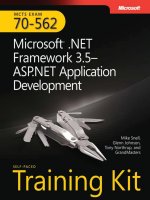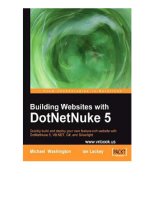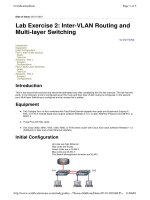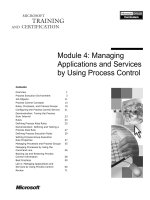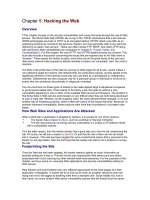1511 WCF 4 5 multi layer services development with entity framework, 3rd edition
Bạn đang xem bản rút gọn của tài liệu. Xem và tải ngay bản đầy đủ của tài liệu tại đây (34.32 MB, 394 trang )
www.it-ebooks.info
WCF 4.5 Multi-Layer Services
Development with Entity
Framework
Third Edition
Build SOA applications on Microsoft platforms with
this hands-on guide
Mike Liu
professional expertise distilled
P U B L I S H I N G
BIRMINGHAM - MUMBAI
www.it-ebooks.info
WCF 4.5 Multi-Layer Services Development with
Entity Framework
Third Edition
Copyright © 2012 Packt Publishing
All rights reserved. No part of this book may be reproduced, stored in a retrieval
system, or transmitted in any form or by any means, without the prior written
permission of the publisher, except in the case of brief quotations embedded in
critical articles or reviews.
Every effort has been made in the preparation of this book to ensure the accuracy
of the information presented. However, the information contained in this book is
sold without warranty, either express or implied. Neither the author, nor Packt
Publishing, and its dealers and distributors will be held liable for any damages
caused or alleged to be caused directly or indirectly by this book.
Packt Publishing has endeavored to provide trademark information about all of the
companies and products mentioned in this book by the appropriate use of capitals.
However, Packt Publishing cannot guarantee the accuracy of this information.
First published: December 2008
Second Edition: June 2010
Third Edition: December 2012
Production Reference: 1101212
Published by Packt Publishing Ltd.
Livery Place
35 Livery Street
Birmingham B3 2PB, UK.
ISBN 978-1-84968-766-9
www.packtpub.com
Cover Image by Artie Ng ()
www.it-ebooks.info
Credits
Author
Project Coordinator
Mike Liu
Yashodhan Dere
Reviewers
Proofreader
Chad Gordon Carter
Aaron Nash
Jason De Oliveira
Indexer
Andrew Rea
Tejal Soni
Jeff Sanders
Edward Spencer
Graphics
Aditi Gajjar
Acquisition Editor
Andrew Duckworth
Lead Technical Editor
Azharuddin Sheikh
Technical Editor
Production Coordinator
Manu Joseph
Cover Work
Manu Joseph
Prasad Dalvi
www.it-ebooks.info
About the Author
Mike Liu studied Mathematics and Software Engineering at Nanjing University
and Brandeis University, graduating with a Bachelor's degree and a Master's degree
respectively. He is a Sun Certified Java Programmer (SCJP), Microsoft Certified
Solution Developer for Visual Studio 6.0, and Microsoft Certified Solution Developer
for .NET. He has been working as a Software Engineer/Architect on various platforms
(DOS, Unix, and Windows), using C/C++, Java, VB/VB.NET, and C#.
Mike started using C# for production development back in the year 2001 when C#
was still in beta stage and he is now working as a Senior Software Engineer for an
investment management firm in Boston Mass.
Mike had his first book MITT: Multi-user Integrated Table-processing Tool Under Unix
published in 1993, and second book Advanced C# Programming published in 2003.
The previous two versions of this book—WCF Multi-tier Services Development with
LINQ and WCF 4.0 Multi-tier Services Development with LINQ to Entities—were
published in 2008 and 2010.
Many thanks to the editors and technical reviewers at Packt
Publishing. Without their help, this book wouldn't be of such high
quality. And thanks to my wife Julia Guo, and to my two sons,
Kevin and James Liu, for their consideration and sacrifices while
I was working on this book.
www.it-ebooks.info
About the Reviewers
Chad Gordon Carter is a completely self-taught web developer. He has been
developing applications since 1998, using classic ASP. Currently, Chad is developing
in ASP.Net 4.0 Framework and using common tools such as Telerik and DevExpress.
Chad is currently working professionally for a financial investment company in
Buckhead, Georgia. Additionally, Chad owns a web development company and
co-owns a flight school in Ball Ground, Geogia.
I would like to thank my wife and son who have relentlessly put up
with my all night geek sessions.
Jason De Oliveira works as CTO for Cellenza (), an
IT consulting company specialized in Microsoft technologies and Agile methodology,
in Paris (France). He is an experienced Manager and Senior Solutions Architect, with
high skills in Software Architecture and Enterprise Architecture.
Jason works for big companies and helps them to realize complex and challenging
software projects. He frequently collaborates with Microsoft and you can find him
quite often at the Microsoft Technology Center (MTC) in Paris.
He loves sharing his knowledge and experience via his blog, by speaking at
conferences, by writing technical books, by writing articles in the technical press,
by giving software courses as MCT, and by coaching co-workers in his company.
www.it-ebooks.info
Microsoft has awarded him since 2011 with the Microsoft® Most Valuable
Professional (MVP C#) Award for his numerous contributions to the Microsoft
community. Microsoft seeks to recognize the best and brightest from technology
communities around the world with the MVP Award. These exceptional and highly
respected individuals come from more than 90 countries, serving their local online
and offline communities and having an impact worldwide. Jason is very proud to
be one of them.
Please feel free to contact him via his blog, if you need any technical assistance or
want to exchange on technical subjects ().
Jason has worked on the following books:
• .NET 4.5 Expert Programming Cookbook (English)
• Visual Studio 2012 - Développez pour le web (French)
I would like to thank my lovely wife Orianne and my beautiful
daughter Julia for supporting me in my work and for accepting long
days and short nights during the week and sometimes even during
the week-end. My life would not be the same without them!
Andrew Rea has been working in Software Development for over eight years.
Primarily working with web technologies on the .NET Platform, Andrew has worked
on several high traffic websites, for well known brands in the United Kingdom. Early
in Andrew's career, he worked with VB6 and Classic ASP, moving into the .NET 1.X
framework and continuing through to the latest versions using C#. Andrew is also an
avid Python, Node.js, and C/C++ developer. Currently Andrew is employed as the
Lead Technical Architect for a global brand in the Accommodations and Destinations
sector of the travel industry.
www.it-ebooks.info
Jeff Sanders is a published author, technical editor, and accomplished technologist.
He is currently employed with Symbolic Systems in the capacity of a Portfolio
Director and Sr. Solutions Architect.
Jeff has years of professional experience in the fields of IT and strategic business
consulting, leading both sales and delivery efforts. He regularly contributes to
certification and product roadmap development with Microsoft, and speaks publicly
on Microsoft enterprise technologies. With his roots in Software Development,
Jeff's areas of expertise include collaboration and content management solutions,
operational intelligence, digital marketing, enterprise project management, distributed
component-based application architectures, object-oriented analysis and design, and
enterprise integration patterns and designs.
Jeff is also the CTO of DynamicShift, a client-focused organization specializing in
Microsoft technologies, specifically Office365/BPOS, SharePoint Server, StreamInsight,
Windows Azure, AppFabric, Business Activity Monitoring, BizTalk Server, and .NET.
He is a Microsoft Certified Trainer, and leads DynamicShift in both training and
consulting efforts.
He enjoys non-work-related travel, spending time with his wife and daughter,
and wishes he had more time for both.
He may be reached at
Edward Spencer is an experienced .NET developer having worked at a number
of software houses in the UK. He has worked on large systems for household names,
encompassing a wide range of technologies. He has been developing applications
with .NET since 2005. His main areas of interest and focus are web-based applications.
www.it-ebooks.info
www.PacktPub.com
Support files, eBooks, discount offers and more
You might want to visit www.PacktPub.com for support files and downloads related to
your book.
Did you know that Packt offers eBook versions of every book published, with PDF and
ePub files available? You can upgrade to the eBook version at www.PacktPub.com and
as a print book customer, you are entitled to a discount on the eBook copy. Get in touch
with us at for more details.
At www.PacktPub.com, you can also read a collection of free technical articles, sign up
for a range of free newsletters and receive exclusive discounts and offers on Packt books
and eBooks.
TM
Do you need instant solutions to your IT questions? PacktLib is Packt's online digital book
library. Here, you can access, read and search across Packt's entire library of books.
Why Subscribe?
•
Fully searchable across every book published by Packt
•
Copy and paste, print and bookmark content
•
On demand and accessible via web browser
Free Access for Packt account holders
If you have an account with Packt at www.PacktPub.com, you can use this to access
PacktLib today and view nine entirely free books. Simply use your login credentials
for immediate access.
Instant Updates on New Packt Books
Get notified! Find out when new books are published by following @PacktEnterprise
on Twitter, or the Packt Enterprise Facebook page.
www.it-ebooks.info
Table of Contents
Preface1
Chapter 1: Web Services and Windows Communication Foundation 7
What is SOA?
8
Web services
8
What is a web service?
8
WSDL10
Web service proxy
10
SOAP11
Web services: standards and specifications
11
WS-I Profiles
12
WS-Addressing
12
WS-Security
12
WS-ReliableMessaging
12
WS-Coordination and WS-Transaction
13
Windows Communication Foundation (WCF)
13
What is WCF?
14
Why is WCF used for SOA?
14
WCF architecture
16
Basic WCF concepts – WCF ABCs
17
Address17
Binding17
Contract18
Endpoint
22
Behavior
23
Hosting
23
Channels
24
Metadata
25
WCF production and development environments
Summary
www.it-ebooks.info
25
26
Table of Contents
Chapter 2: Implementing a Basic HelloWorld WCF Service
27
Chapter 3: Hosting and Debugging the HelloWorld WCF Service
53
Creating the HelloWorld solution and project
Creating the HelloWorldService service contract interface
Implementing the HelloWorldService service contract
Hosting the WCF service in IIS Express
Creating the host application
Testing the host application
IIS Express
Modifying the web.config file
Starting the host application
Creating a client to consume the WCF service
Creating the client application project
Generating the proxy and configuration files
Customizing the client application
Running the client application
Setting the service application to AutoStart
Summary
Hosting the HelloWorld WCF service
Hosting the service in ASP.NET Development Server
Hosting the service in a managed application
Hosting the service in a console application
Consuming the service hosted in a console application
Hosting the service in a Windows service
Hosting the service in the Internet Information Services server using the
HTTP protocol
Preparing the folders and files
Turn on Internet Information Services
Creating the IIS application
Starting the WCF service in IIS
Testing the WCF service hosted in IIS
Hosting the service in the Internet Information Services server using
the TCP protocol
Benefits of hosting a WCF service using the TCP protocol
Preparing the folders and files
Enabling the non-HTTP WCF activation for the hosting machine
Creating the IIS application
Testing the WCF service hosted in IIS using the TCP protocol
Other WCF service hosting options
Debugging the HelloWorld WCF service
Debugging from the client application
Starting the debugging process
[ ii ]
www.it-ebooks.info
27
36
38
39
39
42
43
44
46
47
47
48
49
50
51
52
54
54
55
56
59
60
60
61
63
63
64
64
65
65
66
69
70
71
72
72
72
73
Table of Contents
Debugging on the client application
Stepping into the WCF service
74
75
Directly debugging the WCF service
76
Attaching to a running WCF service process
77
Starting the WCF service in debugging mode
Starting the client application
Running the WCF service and client applications in non-debugging mode
Debugging the WCF service hosted in IIS
Summary
Chapter 4: Implementing a WCF Service in the Real World
Why layer a service?
Creating a new solution and project using WCF templates
Creating the WCF service project
Creating the service interface layer
Creating the service interfaces
Creating the data contracts
Implementing the service contracts
Modifying the app.config file
Testing the service using WCF Test Client
Testing the service using our own client
Adding a business logic layer
Adding the business domain object project
Adding the business logic project
Calling the business logic layer from the service interface layer
Testing the WCF service with a business logic layer
Summary
Chapter 5: Adding Database Support and Exception Handling
Adding a data access layer
Creating the data access layer project
Calling the data access layer from the business logic layer
Preparing the database
Adding the connection string to the configuration file
Querying the database (GetProduct)
Testing the GetProduct method
Updating the database (UpdateProduct)
Adding error handling to the service
Adding a fault contract
Throwing a fault contract exception
Updating the client program to catch the fault exception
Testing the fault exception
Summary
[ iii ]
www.it-ebooks.info
76
77
77
78
79
81
82
83
83
84
85
86
88
91
93
97
104
104
106
110
114
116
117
117
118
120
122
123
124
126
129
132
133
135
137
141
142
Table of Contents
Chapter 6: LINQ: Language Integrated Query
143
Chapter 7: LINQ to Entities: Basic Concepts and Features
167
What is LINQ?
Creating the test solution and project
Datatype var
Automatic properties
Object initializer
Collection initializer
Anonymous types
Extension methods
Lambda expressions
Built-in LINQ extension methods and method syntax
LINQ query syntax and query expression
Built-in LINQ operators
Summary
ORM: Object-Relational Mapping
Entity Framework
LINQ to Entities
Comparing LINQ to Entities with LINQ to Objects
LINQ to SQL
Comparing LINQ to SQL with LINQ to Entities
Creating a LINQ to Entities test application
Creating the data model
Adding a LINQ to Entities item to the project
Generated LINQ to Entities classes
Querying and updating a database table
Querying records
Updating records
Inserting records
Deleting records
Running the program
Viewing generated SQL statements
Viewing SQL statements using ToString
Viewing SQL statements using SQL Profiler
Deferred execution
Checking deferred execution with SQL Profiler
Deferred execution for singleton methods
Deferred execution for singleton methods within sequence expressions
Deferred (lazy) loading versus eager loading
Lazy loading by default
[ iv ]
www.it-ebooks.info
144
144
145
146
147
148
149
150
156
159
160
163
165
168
169
170
171
172
173
174
175
175
181
182
182
183
184
184
185
187
187
189
190
190
192
193
197
198
Table of Contents
Eager loading with the Include method
Comparing lazy loading and eager loading
Joining two tables
Querying a view
Summary
Chapter 8: LINQ to Entities: Advanced Concepts and Features
Calling a stored procedure
Mapping a stored procedure to a new entity class
Modeling a stored procedure
Querying a stored procedure
Mapping a stored procedure to an existing entity class
Inheritance
LINQ to Entities Table per Hierarchy inheritance
Modeling the BaseCustomer and USACustomer entities
Modeling the UKCustomer entity
Generated classes with TPH inheritance
Testing the TPH inheritance
199
201
201
202
203
205
205
206
206
207
208
212
212
213
216
217
217
LINQ to Entities Table per Type inheritance
220
Handling simultaneous (concurrent) updates
Detecting conflicts using a data column
227
228
Preparing database tables
Modeling USACustomer1 and UKCustomer1 entities
Generated classes with TPT inheritance
Testing the TPT inheritance
The Concurrency Mode property
Adding another entity data model
Writing the test code
Testing the conflicts
Turning on concurrency control
Detecting conflicts using a version column
Adding a version column
Modeling the Products table with a version column
Writing the test code
Testing the conflicts
Transaction support
Implicit transactions
Explicit transactions
Summary
Chapter 9: Applying LINQ to Entities to a WCF Service
Creating the LINQNorthwind solution
Modeling the Northwind database
Creating the business domain object project
Using LINQ to Entities in the data access layer
Adding a reference to the BDO project
[v]
www.it-ebooks.info
221
222
223
223
228
229
231
232
232
236
236
237
238
239
239
240
241
244
245
246
246
247
249
249
Table of Contents
Creating GetProduct in the data access layer
Creating UpdateProduct in the data access layer
Creating the business logic layer
Creating the service interface layer
Testing the service with the WCF Test Client
Testing concurrency with our own client
Creating the test client
250
251
253
254
260
262
262
Testing the GetProduct and UpdateProduct operations
Testing concurrent update manually
Testing concurrent updates automatically
Summary
269
271
274
280
Implementing the GetProduct functionality
Implementing the UpdateProduct functionality
Chapter 10: Distributed Transaction Support of WCF
Creating the DistNorthwind solution
Hosting the WCF service in IIS
Testing the transaction behavior of the WCF service
Creating a client to call the WCF service sequentially
Testing the sequential calls to the WCF service
Wrapping the WCF service calls in one transaction scope
Testing multiple database support of the WCF service
Creating a new WCF service
Calling the new WCF service in the client application
Testing the WCF service with two databases
264
265
281
282
284
285
286
293
295
296
297
298
303
Enabling distributed transaction support
Enabling transaction flow in service binding
306
306
Modifying the service operation contract to allow a transaction flow
Modifying the service operation implementation to require a
transaction scope
Understanding the distributed transaction support of a WCF service
Testing the distributed transaction support of the WCF service
Configuring the Microsoft Distributed Transaction Coordinator
Configuring the firewall
Propagating a transaction from the client to the WCF service
308
Tradeoffs of distributed transactions
Summary
319
319
Enabling transaction flow on the service hosting application
Testing distributed transaction support with one database
Testing the distributed transaction support with two databases
Chapter 11: WCF Security
WCF security components
WCF authorization
307
309
310
311
311
313
314
314
315
321
321
322
[ vi ]
www.it-ebooks.info
Table of Contents
WCF auditing
WCF transfer security
WCF security modes
WCF transport security
WCF message security
WCF mixed security
WCF transport and message (both) security
Authentication options for transport security
Authentication options for message security
Hosting a WCF service using Basic Authentication
Setting up the service
Enabling the Basic Authentication feature
Configuring Basic Authentication on IIS
Configuring the HTTPS protocol
Configuring Basic Authentication on the service
Testing the service with Basic Authentication
Hosting a WCF service with Windows Authentication
WCF Security Guidance
Summary
322
323
323
324
325
325
325
325
326
327
327
328
329
331
333
336
338
340
340
Chapter 12: Extending WCF Services
341
Index
363
WCF runtime architecture
Why extend WCF services?
WCF extension points
Client-side extension points
Service-side extension points
Extending a WCF service
WCF extension classes
WCF behavior classes
WCF behavior element classes
Applying the extensions
Extending HelloWorldService
Setting up the service
Creating the extension project
Creating an extension class
Creating a behavior class
Creating a behavior element class
Applying the extension to HelloWorldService
Testing the extended HelloWorldService
Summary
[ vii ]
www.it-ebooks.info
341
343
343
344
345
345
346
347
348
348
349
349
350
351
354
356
358
359
361
www.it-ebooks.info
Preface
WCF is Microsoft's recommended model for building services and Entity Framework
is Microsoft's preferred ORM for accessing underlying data storages. Learning WCF
and Entity Framework has become essential and critical for every software developer
to survive in this SOA world.
This book is a step-by-step tutorial to guide you through learning WCF, Entity
Framework, LINQ, and LINQ to Entities. You will be guided to create five WCF and
Entity Framework solutions, of which three are multi-layered real-world WCF service
solutions, so you will not only be reading, but also be coding through the book, to
gain practical experience of WCF and Entity Framework. Various test clients will be
associated with each solution and all solutions can be built and run independently
of other solutions. Clear instructions and relevant screenshots will make sure you
won't get lost in the world of WCF and Entity Framework. Configuration files, host
applications, test clients, and WCF services for each solution will also be available
to download for you to examine, modify, and debug from the outside in.
This book focuses on the essentials of using WCF and Entity Framework, rather than
providing a reference to every single possibility. It leaves the reference material online
where it belongs, and concentrates instead on practical examples, code, and advice.
What this book covers
Chapter 1, Web Services and Windows Communication Foundation, covers basic concepts
of web services and WCF.
Chapter 2, Implementing a Basic HelloWorld WCF Service, discusses how a simple
HelloWorld WCF service is implemented, hosted, and consumed.
www.it-ebooks.info
Preface
Chapter 3, Hosting and Debugging the HelloWorld WCF Service, discusses various hosting
and debugging techniques of WCF services.
Chapter 4, Implementing a WCF Service in the Real World, explains how to create a layered
WCF service with an interface layer and a business logic layer.
Chapter 5, Adding Database Support and Exception Handling, explains how to add a data
access layer and fault message handling to the previously created WCF service.
Chapter 6, LINQ: Language Integrated Query, discusses LINQ-related language features
such as anonymous types, extension methods, and lambda expressions.
Chapter 7, LINQ to Entities: Basic Concepts and Features, covers the basic concepts and
features of LINQ to Entities such as LINQ to Entities designer, querying and updating
tables, deferred execution, and lazy/eager loading.
Chapter 8, LINQ to Entities: Advanced Concepts and Features, covers advanced concepts
and features of LINQ to Entities such as stored procedure, inheritance, concurrency
control, and transaction support.
Chapter 9, Applying LINQ to Entities to a WCF Service, discusses how to recreate the
data access layer of a WCF service with LINQ to Entities.
Chapter 10, Distributed Transaction Support of WCF, explains how to add distributed
transaction support to a WCF service.
Chapter 11, WCF Security, covers basic security features and settings of WCF, and
hosts a WCF service with Basic Authentication, SSL, and Windows Authentication.
Chapter 12, Extending WCF Services, explains various extension points of WCF
services and extends a WCF service with custom behaviors.
What you need for this book
You need the following software:
• Microsoft .NET Framework 4.5
• Microsoft Visual Studio 2012 Ultimate, Premium, or Professional
• Microsoft SQL Server 2012, 2008, 2005, or Express
• Internet Information Server 7.0, 7.5, or 8.0
• Windows 7 or Windows 8
[2]
www.it-ebooks.info
Preface
Who this book is for
This book is for C#, VB.NET, and C++ developers who are eager to get started
with WCF and Entity Framework, and want a book that is practical and rich with
examples from the very beginning.
Developers and architects evaluating SOA implementation technologies for
their company will find this book particularly useful because it gets you started
with Microsoft's tools for SOA and shows you how to customize our examples
for your prototypes.
This book presumes basic knowledge of C# or C++. Previous experience with
Visual Studio will be helpful but is not required, as detailed instructions are
given throughout the book.
Conventions
In this book, you will find a number of styles of text that distinguish between
different kinds of information. Here are some examples of these styles, and an
explanation of their meaning.
Code words in text are shown as follows: "For a Microsoft ASMX web service,
you can see the WSDL by adding ?WSDL at the end of the web service URL, say
http://localhost/MyService/MyService.asmx?WSDL."
A block of code is set as follows:
namespace MyWCF.EasyNorthwind.MessageContracts
{
/// <summary>
/// Service Contract Class - GetProductResponse
/// </summary>
[System.ServiceModel.MessageContract(IsWrapped = false)]
public partial class GetProductResponse
{
private MyWCF.EasyNorthwind.DataContracts.Product product;
[System.ServiceModel.MessageBodyMember(Name = "Product")]
public MyWCF.EasyNorthwind.DataContracts.Product Product
{
get { return product; }
set { product = value; }
}
}
}
[3]
www.it-ebooks.info
Preface
Any command-line input or output is written as follows:
"C:\Program Files\Microsoft SDKs\Windows\v8.0A\bin\NETFX 4.0 Tools\
SvcUtil.exe" http://localhost:1054/HostDevServer/HelloWorldService.
svc?wsdl/out:HelloWorldServiceRef.cs /config:app.config
New terms and important words are shown in bold. Words that you see on the
screen, in menus or dialog boxes for example, appear in the text like this: "If the
Open Project dialog box pops up, click on Cancel to close it."
Warnings or important notes appear in a box like this.
Tips and tricks appear like this.
Reader feedback
Feedback from our readers is always welcome. Let us know what you think about
this book—what you liked or may have disliked. Reader feedback is important for
us to develop titles that you really get the most out of.
To send us general feedback, simply send an e-mail to ,
and mention the book title via the subject of your message.
If there is a book that you need and would like to see us publish, please send us a
note in the SUGGEST A TITLE form on www.packtpub.com or e-mail suggest@
packtpub.com.
If there is a topic that you have expertise in and you are interested in either writing
or contributing to a book, see our author guide on www.packtpub.com/authors.
Customer support
Now that you are the proud owner of a Packt book, we have a number of things to
help you to get the most from your purchase.
[4]
www.it-ebooks.info
Preface
Downloading the example code
You can download the example code files for all Packt books you have purchased
from your account at . If you purchased this book
elsewhere, you can visit and register to
have the files e-mailed directly to you.
Errata
Although we have taken every care to ensure the accuracy of our content, mistakes
do happen. If you find a mistake in one of our books—maybe a mistake in the text or
the code—we would be grateful if you would report this to us. By doing so, you can
save other readers from frustration and help us improve subsequent versions of this
book. If you find any errata, please report them by visiting ktpub.
com/support, selecting your book, clicking on the errata submission form link, and
entering the details of your errata. Once your errata are verified, your submission will
be accepted and the errata will be uploaded on our website, or added to any list of
existing errata, under the Errata section of that title. Any existing errata can be viewed
by selecting your title from />
Piracy
Piracy of copyright material on the Internet is an ongoing problem across all media.
At Packt, we take the protection of our copyright and licenses very seriously. If you
come across any illegal copies of our works, in any form, on the Internet, please
provide us with the location address or website name immediately so that we can
pursue a remedy.
Please contact us at with a link to the suspected
pirated material.
We appreciate your help in protecting our authors, and our ability to bring
you valuable content.
Questions
You can contact us at if you are having a problem with
any aspect of the book, and we will do our best to address it.
[5]
www.it-ebooks.info
www.it-ebooks.info
Web Services and Windows
Communication Foundation
A web service is a software system designed to support interoperable machine-tomachine interaction over a network. Web services have been around for a while,
but it is the service-oriented architecture (SOA) that makes web services much
more popular today. Now with Windows Communication Foundation (WCF),
a new era has begun for developing services, including web services, on the
Microsoft platform.
In this chapter, we will learn concepts and definitions related to SOA, web services,
and WCF. We will discuss each of the following in detail:
• What is SOA?
• Web service and its relation to SOA
• Standards and specifications for web services
• What is WCF?
• Use of WCF for SOA
• WCF architecture
• Basic WCF concepts
• WCF production and development environments
www.it-ebooks.info
Web Services and Windows Communication Foundation
What is SOA?
SOA is the acronym for service-oriented architecture. SOA is an architectural design
pattern by which several guiding principles determine the nature of the design.
Basically, SOA states that every component of a system should be a service, and the
system should be composed of several loosely-coupled services. A service here means
a unit of a program that serves a business process. Loosely-coupled here means that
these services should be independent of each other so that changing one of them
should not affect any other services.
SOA is neither a specific technology nor a specific language. It is just a blueprint
or a system design approach. It is an architectural model that aims to enhance the
efficiency, agility, and productivity of an enterprise system. The key concepts of
SOA are services, high interoperability, and loose coupling.
Web services
There are many approaches to realizing SOA, but the most popular and practical
one is using web services.
What is a web service?
As mentioned in the beginning of this chapter, a web service is a software system
designed to support interoperable machine-to-machine interaction over a network.
A web service is typically hosted on a remote machine (provider) and called by a
client application (consumer) over a network. After the provider of a web service
publishes the service, the client can discover it and invoke it. The communications
between a web service and a client application to be used can be done by sending
XML messages. A web service is hosted within a web server and HTTP is used as
the transport protocol between the server and the client applications. The following
diagram shows the interaction of web services:
Web Services Directory (UDDI)
2. Discover
1. Publish
3. Bind and Invoke
Web Services
Client
Web Services
Provider
[8]
www.it-ebooks.info


